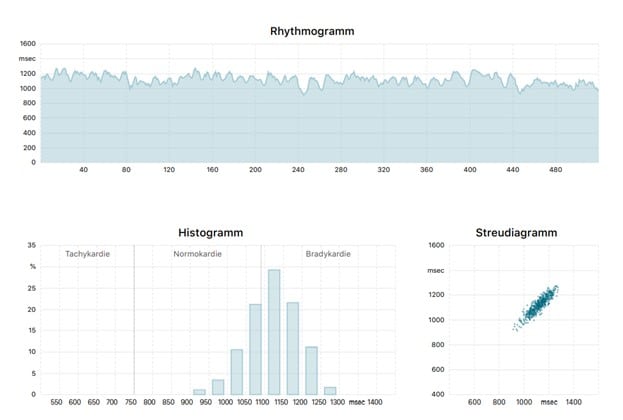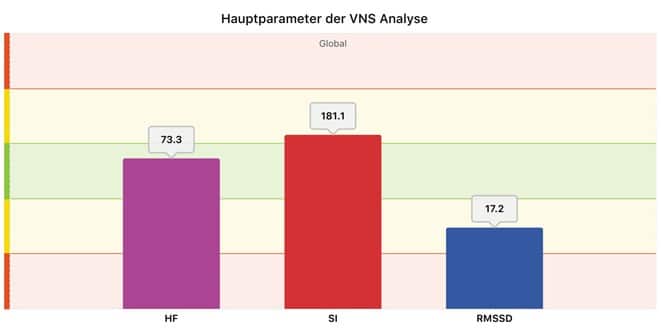Stress diagnostics / HRV measurement
What does Heart Rate Variability (HRV) measurement mean?
How variable is your heartbeat? How regular or irregular is the rhythm at which your heart beats?
In the HRV measurement, the intervals between successive heartbeats are compared by recording the heart rhythm using a chest strap and the heart rate variability is determined from this.
In medicine, the heartbeat is usually measured as “heart rate” or “pulse”. This gives us an indication of how often the heart beats per minute. The pulse rate, for example, is 60/minute. The HRV measurement, on the other hand, is about how regularly or irregularly the heart beats. Perhaps you are now assuming that your heart always beats at a very regular, almost staccato rhythm? This is not the case. The heartbeat is altered by the autonomic nervous system (ANS) depending on the situation. For example, the heart beats faster when you inhale and slower when you exhale. This situation-dependent regulation by the VNS is physiological and should not be confused with pathological cardiac arrhythmia.

Fig. 1 : Graphical representation of the recorded heart rhythm
If high variations in the heartbeat rhythm are detected during the measurement (=high variability), this means that the heart reacts quickly to the smallest changes, which in turn means that the autonomic nervous system is able to adapt to internal and external stimuli and that the person is better able to adapt to physical or emotional stress. High variability is therefore a sign of good adaptability and your body’s willingness to perform at a high level.
The HRV measurement…
- Measures the fitness of the autonomic nervous system
- Gives a statement about the body’s resilience and ability to regenerate, about physical and mental performance
- Indicates whether you should exercise or rest
What information do I get from the HRV measurement?
The vegetative (autonomic) nervous system (VNS) is made up of two parts: “sympathetic” and “parasympathetic”. It is the highest control center in the body and regulates all vital functions and organ systems.
The sympathetic nervous system is responsible for physical performance and is also known as the “stress nerve”. It puts the body on alert and increases the ability to react, e.g. during stress or physical activity. It increases the heart rate.
The parasympathetic nervous system is responsible for physical recovery, relaxation and regenerative processes (e.g. digestion, blood pressure regulation, muscle growth, hair growth). It is also known as the “relaxation nerve”. It slows down the heartbeat.
Do you have the necessary balance between body tension and body relaxation? That is the crucial question and the HRV measurement gives us the answer.
Low and high Heart Rate Variability
If the HRV measurement shows a low heart rate variability, this means that one of the two parts of the VNS is dominant. And this dominant part then sends stronger signals to the heart.
If the HRV measurement shows a high heart rate variability, this means that the body is listening equally to both sympathetic and parasympathetic influences. The nervous system is in balance and the body is ready for high performance.
Possible influencing variables in connection with a vegetative imbalance include organic diseases, biological factors and psychological disorders, as well as training and lifestyle habits such as poor diet, lack of exercise, lack of exposure to appropriate stimuli such as cold or light, sleeping habits, alcohol consumption, training volume and intensity, the relationship between tension and relaxation/breaks.
In nature, we normally have a constant alternation of tension and relaxation. This creates a natural balance.
Implementation:
After a 10-minute rest period, the measurement is carried out in a sitting position. The heartbeat is recorded using a chest strap and transmitted wirelessly to the software. A rhythmogram and scatter diagram are created and the parameters resting heart rate, sympathetic nervous system (body tension) and parasympathetic nervous system (body relaxation) are mathematically calculated and displayed based on the recorded heart rate variability. A single measurement takes about 5-10 minutes, depending on the pulse rate. It is possible to carry out a second measurement afterwards under breathing guidance.
We evaluate the results together with you and they are made available to you as a PDF file.

For more information, see: www.vnsanalyse.de
Further topics (selection):
Without diagnostics you are in the dark …
We want to treat you in the best possible and individualized way. To do this, it is necessary to carry out a comprehensive diagnosis. Often symptoms are not due to a single cause, but various stresses accumulate over time. Sometimes they reinforce each other and at some point the barrel overflows. Which stresses or disruptive factors have caused the barrel to overflow in your case? Where are you deficient? Where is there an imbalance? How can we work together to relieve your body-mind system and remove blockages to healing?
Let’s take the path together and make an appointment now.
Your contact persons
Contact and appointment possible at any time
Do one or more of the above points apply to you and would you like to do something for your health? Are you curious? Please feel free to contact us by phone to make an appointment.
You can reach us according to our opening hours at tel. 030 79016533. We look forward to your call or message.











